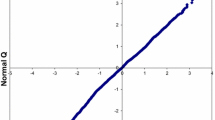Abstract
The applied context of this paper is the exploration for petroleum resources, like petroleum accumulations in different deposits, where the most promising deposits are likely to be drilled first, based on some size indicators, so-called creaming. The paper explores creaming models in the context of sampling with probabilities in proportion to size, for which a lognormal size distribution has nice analytical features. It departs from the traditional paradigm in petroleum resource assessment. Instead of conceiving a finite population being depleted over time in a decaying fashion with respect to size, the situation is studied within the framework of independent observations (infinite population) and an exploration maturity-dependent creaming factor. The theoretical and practical consequences for inference on the parent population and the probabilities and expectations linked to future discoveries are studied. The theory applies to the issue of remaining sizes of petroleum resources to be found within different future discovery horizons on the mature part of the Norwegian Continental Shelf. The aim is to obtain reasonable and useful predictions, and not to provide the best possible explanation of the exploratory behavior itself.








Similar content being viewed by others
References
Andreatta G, Kaufman GW (1986) Estimation of finite population properties when sampling is without replacement and proportional to magnitude. J Am Stat Assoc 81(395):657–666
Barouch E, Kaufman GW (1967) Oil and gas discovery modelled as sampling proportional to random size. MIT Alfred P. Sloan School of Management, Cambridge, Mass. http://dspace.mit.edu/handle/1721.1/48701
Charpentier DR, Dolton GL, Ulmishek GF (1995) Annotated bibliography of methodology for assessment of undiscovered oil and gas resources. Nonrenew Resour 4(2):154–185
Chen Z, Sinding-Larsen R (1994) Estimating number and field size distribution in frontier sedimentary basins using a Pareto model. Nat Resour Res 3(2):91–95
Halbouty MT (2001) Giant oil and gas fields of the 1990s. An introduction. Presentation at symposium, giant oil and gas fields of the decade 1990–2000, AAPG Convention, Denver, CO, June 5, 2001, downloaded Jan 12, 2016. http://www.searchanddiscovery.com/documents/halbouty03
Kaufman GM (1992) Statistical issues in the assessment of undiscovered oil and gas resources. MIT-CEEPR-92-010WP. http://dspace.mit.edu/bitstream/handle/1721.1/50204/35719963.pdf?sequence=1
Kaufman GM, Balcer Y, Kruyt D (1975) A probabilistic model of oil and gas discoveries. In: Dunn JD (ed) Methods of estimating the volume of oil and gas reserves. Studies in geology, vol 1, pp 113–142. American Assoc. Petroleum Geologists
Kaufman GM, Faith R, Schuenemeyer JH (2016) Has the largest field been discovered yet? PETRIMES and GRASP 25 years later. Math Geosci. doi:10.1007/s11004-016-9652-z
Lee PJ, Wang PCC (1985) Prediction of oil and gas pool sizes when discovery record is available. Math Geol 17(2):95–113
Meisner J, Demirmen F (1981) The creaming method: a Bayesian procedure to forecast future oil and gas discoveries in mature exploration provinces. J R Stat Soc Ser A 144(1):1–31
R Core Team (2013) R: a language and environment for statistical computing. R Foundation for Statistical Computing, Vienna, Austria. http://www.R-project.org/
RNB 2014 (2014) Resource account for the Norwegian Continental Shelf as of December 31, 2013. The Norwegian Petroleum Directorate (Data file: Publiserte-tabeller-RNB2014.xlsx). http://www.npd.no/en/Topics/Resource-accounts-and--analysis/Temaartikler/Resource-accounts/2013/
Schuenemeyer JH, Drew LJ (1983) A procedure to estimate the parent population of the size oil and gas fields as revealed by a study of economic truncation. Math Geol 15(1):145–161
Shmueli G (2010) To explain or to predict? Stat Sci 25(3):289–310
Xu J, Sinding-Larsen R (2005) How to choose priors for Bayesian estimation of the discovery process model. Nat Resour Res 14(3):211–233
Acknowledgments
The authors wish to thank Gordon M. Kaufman for valuable feedback on modeling aspects of this paper and two anonymous referees for constructive comments.
Author information
Authors and Affiliations
Corresponding author
Rights and permissions
About this article
Cite this article
Lillestøl, J., Sinding-Larsen, R. Creaming and the Likelihood of Discovering Additional Giant Petroleum Fields. Math Geosci 49, 67–83 (2017). https://doi.org/10.1007/s11004-016-9657-7
Received:
Accepted:
Published:
Issue Date:
DOI: https://doi.org/10.1007/s11004-016-9657-7




